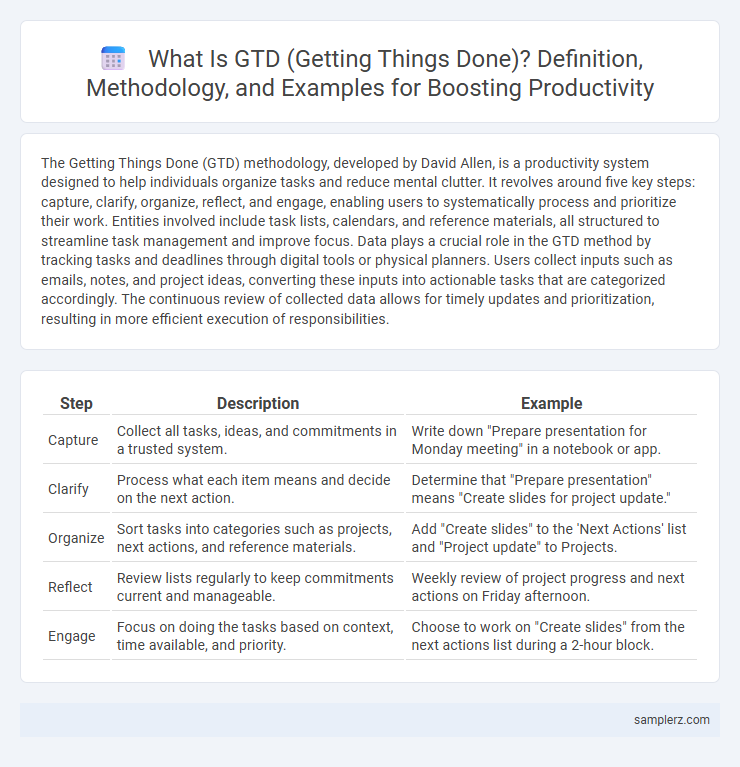The Getting Things Done (GTD) methodology, developed by David Allen, is a productivity system designed to help individuals organize tasks and reduce mental clutter. It revolves around five key steps: capture, clarify, organize, reflect, and engage, enabling users to systematically process and prioritize their work. Entities involved include task lists, calendars, and reference materials, all structured to streamline task management and improve focus. Data plays a crucial role in the GTD method by tracking tasks and deadlines through digital tools or physical planners. Users collect inputs such as emails, notes, and project ideas, converting these inputs into actionable tasks that are categorized accordingly. The continuous review of collected data allows for timely updates and prioritization, resulting in more efficient execution of responsibilities.
Table of Comparison
| Step | Description | Example |
|---|---|---|
| Capture | Collect all tasks, ideas, and commitments in a trusted system. | Write down "Prepare presentation for Monday meeting" in a notebook or app. |
| Clarify | Process what each item means and decide on the next action. | Determine that "Prepare presentation" means "Create slides for project update." |
| Organize | Sort tasks into categories such as projects, next actions, and reference materials. | Add "Create slides" to the 'Next Actions' list and "Project update" to Projects. |
| Reflect | Review lists regularly to keep commitments current and manageable. | Weekly review of project progress and next actions on Friday afternoon. |
| Engage | Focus on doing the tasks based on context, time available, and priority. | Choose to work on "Create slides" from the next actions list during a 2-hour block. |
Introduction to GTD Methodology
The GTD (Getting Things Done) methodology revolves around capturing all tasks and ideas in a trusted system to free the mind from clutter. It emphasizes five key steps: capture, clarify, organize, reflect, and engage, enabling improved focus and productivity. This approach helps individuals manage commitments and projects with clarity and efficiency, reducing stress and enhancing task completion.
Clarifying Tasks with the GTD Approach
The GTD methodology emphasizes clarifying tasks by breaking down all inputs into actionable items to reduce mental clutter and increase focus. Each task is defined by specifying the desired outcome and the very next action required, enabling clear decision-making and efficient progress. This approach enhances productivity by transforming vague intentions into concrete, manageable steps that streamline workflow and minimize procrastination.
Capturing Inputs: The GTD Inbox Example
The GTD methodology emphasizes capturing inputs efficiently by using a dedicated inbox to collect all tasks, ideas, and reminders without distraction. This centralized inbox allows for immediate processing and organization, ensuring nothing is overlooked or forgotten. Regularly emptying the GTD inbox enhances focus and productivity by maintaining a clear mental space.
Processing and Organizing: The GTD Workflow
The GTD workflow emphasizes processing and organizing tasks by capturing all inputs, clarifying actionable steps, and categorizing them into contexts such as Projects, Next Actions, and Waiting For lists. This structured approach ensures that all commitments are consistently reviewed and prioritized, minimizing mental clutter and enhancing productivity. Efficiently sorting tasks into appropriate lists allows for clear focus and timely execution within the GTD methodology.
Next Actions: Breaking Down Projects with GTD
Breaking down projects into Next Actions in GTD methodology enhances productivity by creating clear, manageable steps that prevent overwhelm. Each Next Action is a tangible task focused on immediate progress, enabling momentum and reducing procrastination. This approach improves task clarity and ensures consistent forward movement within complex projects.
Weekly Review: Sustaining Productivity with GTD
The Weekly Review in the Getting Things Done (GTD) methodology is crucial for sustaining productivity by systematically capturing, clarifying, and organizing tasks and projects. This process involves reviewing all actionable items, updating project lists, and reflecting on priorities to maintain clarity and control over commitments. Consistent execution of the Weekly Review helps prevent task overload and ensures alignment with personal and professional goals.
Using Lists: Contextual Task Management in GTD
Using lists in GTD methodology enhances productivity by organizing tasks based on context, such as location, resources, or energy levels. Contextual task management allows individuals to focus on actionable items relevant to their current situation, reducing cognitive load and improving efficiency. Examples include separating lists into categories like "@Office," "@Home," or "@Calls" to streamline decision-making and prioritize effectively.
GTD Example: Managing Email Overload
Managing email overload using the GTD methodology involves capturing all incoming emails into a trusted system for review. Each message is processed by deciding whether to delete, delegate, defer, or do the action immediately if it takes less than two minutes. Organizing emails into categorized folders or projects ensures quick retrieval and reduces cognitive load, enhancing productivity and focus.
Implementing GTD with Digital Tools
Implementing GTD with digital tools enhances task management by leveraging apps like Todoist, Evernote, and Trello to capture, organize, and review actionable items seamlessly. These tools facilitate the GTD workflow by providing real-time synchronization, context tagging, and customizable project boards that streamline next-action planning and reduce cognitive load. Utilizing automation features and integration with calendars and email further optimizes productivity and ensures consistent execution of key GTD principles.
Real-life Case Study: GTD in a Busy Workweek
A real-life case study of GTD (Getting Things Done) in a busy workweek demonstrates how prioritizing tasks using a clear inbox and context-based lists improves focus and efficiency. By capturing, clarifying, and organizing tasks into actionable steps, the individual reduced stress and increased productivity despite high workloads and tight deadlines. Implementing weekly reviews ensured continuous alignment with goals and adaptability to changing priorities, making GTD an effective methodology for managing complex schedules.

example of GTD (Getting Things Done) in methodology Infographic
 samplerz.com
samplerz.com